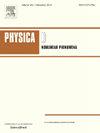三耦合Lakshmanan-Porsezian-Daniel模型长期渐近性的非线性最陡下降方法
IF 2.7
3区 数学
Q1 MATHEMATICS, APPLIED
引用次数: 0
摘要
本文用非线性最陡下降法研究了初始数据为Schwartz的三耦合Lakshmanan-Porsezian-Daniel (LPD)模型的长期渐近行为。基于LPD模型的Lax对,构造了一个与初值问题相关联的Riemann-Hilbert问题。进一步,一系列变换通过Deift-Zhou非线性最陡下降法将黎曼-希尔伯特问题转化为可处理的形式。然后通过重构公式得到LPD模型的长时间渐近性。2 × 2谱问题的区别在于我们以分块形式处理矩阵,其优点是可以将矩阵视为分块对角矩阵,而不必严格对角,这就需要函数δ(k)的复杂性。这种方法的主要限制是它不能直接获取溶液δ(k)。为了解决这个问题,我们使用了一个包含δ(k)−I⋅detδ(k)的项,那么该项可以渐近估计为O(t−1/2)。与非线性Schrödinger方程和Hirota方程相比,我们问题的长时间渐近分析的显著特征在于存在三个临界点。本文章由计算机程序翻译,如有差异,请以英文原文为准。
The nonlinear steepest descent approach to the long-time asymptotics of the three-coupled Lakshmanan–Porsezian–Daniel model
In this paper, the long-time asymptotic behavior of the three-coupled Lakshmanan–Porsezian–Daniel (LPD) model with Schwartz initial data is investigated by the nonlinear steepest descent approach. Based on the Lax pair of the LPD model, a Riemann–Hilbert problem associated with the initial value problem is constructed. Further a sequence of transformations change the Riemann–Hilbert problem into a tractable form via the Deift–Zhou nonlinear steepest descent approach. Then the long-time asymptotics of the LPD model is obtained through reconstruction formula. What distinguishes the 2 × 2 spectral problem is that we treat the matrix in a block form, the advantage of which is that the matrix can be regarded as a block diagonal matrix without being strictly diagonal, necessitating the complexity of the function . The primary limitation of this approach is that it does not enable direct acquisition of the solution . To address this challenge, we employ a term involves , then the term can be asymptotically estimated as . The distinguishing feature of the long-time asymptotic analysis for our problem, when compared with the nonlinear Schrödinger equation and Hirota equation, lies in the presence of three critical points.
求助全文
通过发布文献求助,成功后即可免费获取论文全文。
去求助
来源期刊

Physica D: Nonlinear Phenomena
物理-物理:数学物理
CiteScore
7.30
自引率
7.50%
发文量
213
审稿时长
65 days
期刊介绍:
Physica D (Nonlinear Phenomena) publishes research and review articles reporting on experimental and theoretical works, techniques and ideas that advance the understanding of nonlinear phenomena. Topics encompass wave motion in physical, chemical and biological systems; physical or biological phenomena governed by nonlinear field equations, including hydrodynamics and turbulence; pattern formation and cooperative phenomena; instability, bifurcations, chaos, and space-time disorder; integrable/Hamiltonian systems; asymptotic analysis and, more generally, mathematical methods for nonlinear systems.
 求助内容:
求助内容: 应助结果提醒方式:
应助结果提醒方式:


